technical data SKODA FABIA 2003 1.G / 6Y Owners Manual
[x] Cancel search | Manufacturer: SKODA, Model Year: 2003, Model line: FABIA, Model: SKODA FABIA 2003 1.G / 6YPages: 233, PDF Size: 32.04 MB
Page 184 of 233
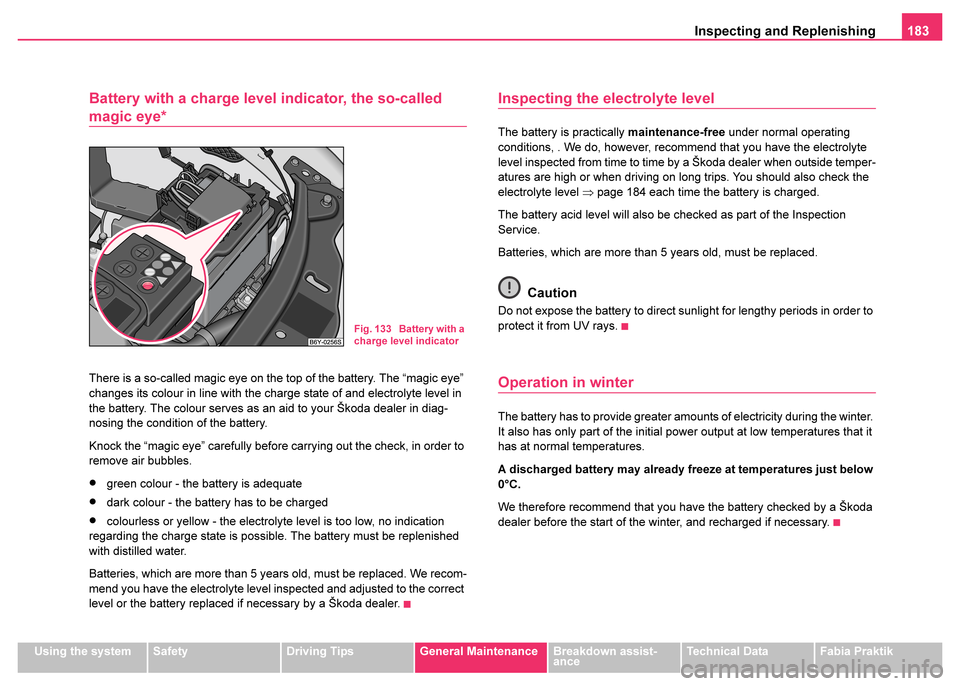
Inspecting and Replenishing183
Using the systemSafetyDriving TipsGeneral MaintenanceBreakdown assist-
anceTechnical DataFabia Praktik
Battery with a charge level indicator, the so-called
magic eye*
There is a so-called magic eye on the top of the battery. The “magic eye”
changes its colour in line with the charge state of and electrolyte level in
the battery. The colour serves as an aid to your Škoda dealer in diag-
nosing the condition of the battery.
Knock the “magic eye” carefully before carrying out the check, in order to
remove air bubbles.
•green colour - the battery is adequate
•dark colour - the battery has to be charged
•colourless or yellow - the electrolyte level is too low, no indication
regarding the charge state is possible. The battery must be replenished
with distilled water.
Batteries, which are more than 5 years old, must be replaced. We recom-
mend you have the electrolyte level inspected and adjusted to the correct
level or the battery replaced if necessary by a Škoda dealer.
Inspecting the electrolyte level
The battery is practically maintenance-free under normal operating
conditions, . We do, however, recommend that you have the electrolyte
level inspected from time to time by a Škoda dealer when outside temper-
atures are high or when driving on long trips. You should also check the
electrolyte level ⇒page 184 each time the battery is charged.
The battery acid level will also be checked as part of the Inspection
Service.
Batteries, which are more than 5 years old, must be replaced.
Caution
Do not expose the battery to direct sunlight for lengthy periods in order to
protect it from UV rays.
Operation in winter
The battery has to provide greater amounts of electricity during the winter.
It also has only part of the initial power output at low temperatures that it
has at normal temperatures.
A discharged battery may already freeze at temperatures just below
0°C.
We therefore recommend that you have the battery checked by a Škoda
dealer before the start of the winter, and recharged if necessary.
Fig. 133 Battery with a
charge level indicator
Page 186 of 233
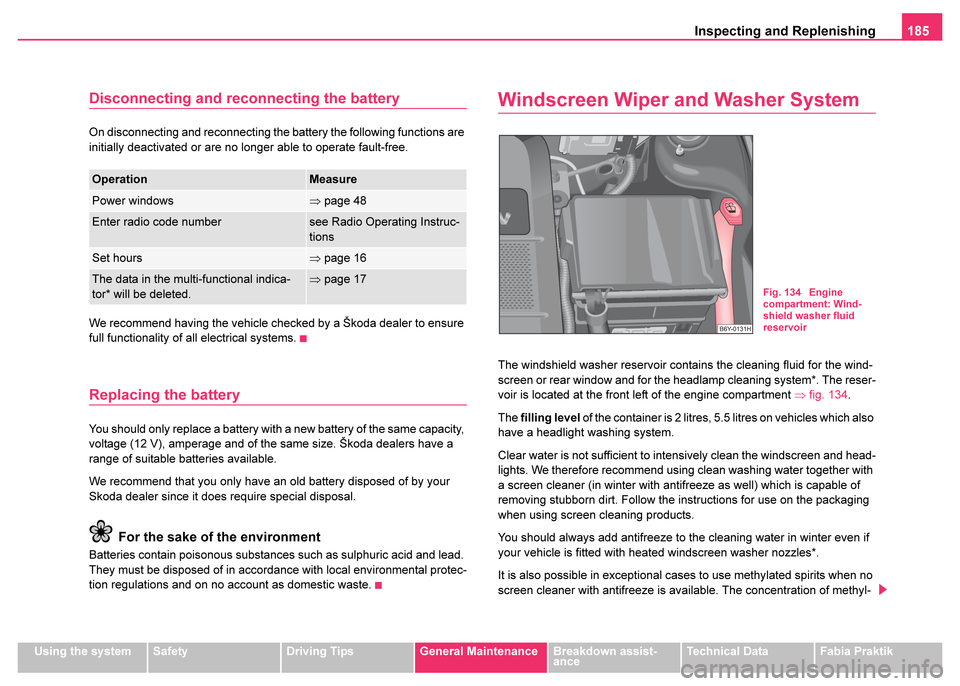
Inspecting and Replenishing185
Using the systemSafetyDriving TipsGeneral MaintenanceBreakdown assist-
anceTechnical DataFabia Praktik
Disconnecting and reconnecting the battery
On disconnecting and reconnecting the battery the following functions are
initially deactivated or are no longer able to operate fault-free.
We recommend having the vehicle checked by a Škoda dealer to ensure
full functionality of all electrical systems.
Replacing the battery
You should only replace a battery with a new battery of the same capacity,
voltage (12 V), amperage and of the same size. Škoda dealers have a
range of suitable batteries available.
We recommend that you only have an old battery disposed of by your
Skoda dealer since it does require special disposal.
For the sake of the environment
Batteries contain poisonous substances such as sulphuric acid and lead.
They must be disposed of in accordance with local environmental protec-
tion regulations and on no account as domestic waste.
Windscreen Wiper and Washer System
The windshield washer reservoir contains the cleaning fluid for the wind-
screen or rear window and for the headlamp cleaning system*. The reser-
voir is located at the front left of the engine compartment ⇒fig. 134.
The filling level of the container is 2 litres, 5.5 litres on vehicles which also
have a headlight washing system.
Clear water is not sufficient to intensively clean the windscreen and head-
lights. We therefore recommend using clean washing water together with
a screen cleaner (in winter with antifreeze as well) which is capable of
removing stubborn dirt. Follow the instructions for use on the packaging
when using screen cleaning products.
You should always add antifreeze to the cleaning water in winter even if
your vehicle is fitted with heated windscreen washer nozzles*.
It is also possible in exceptional cases to use methylated spirits when no
screen cleaner with antifreeze is available. The concentration of methyl-
OperationMeasure
Power windows⇒ page 48
Enter radio code numbersee Radio Operating Instruc-
tions
Set hours⇒page 16
The data in the multi-functional indica-
tor* will be deleted.⇒page 17Fig. 134 Engine
compartment: Wind-
shield washer fluid
reservoir
Page 188 of 233
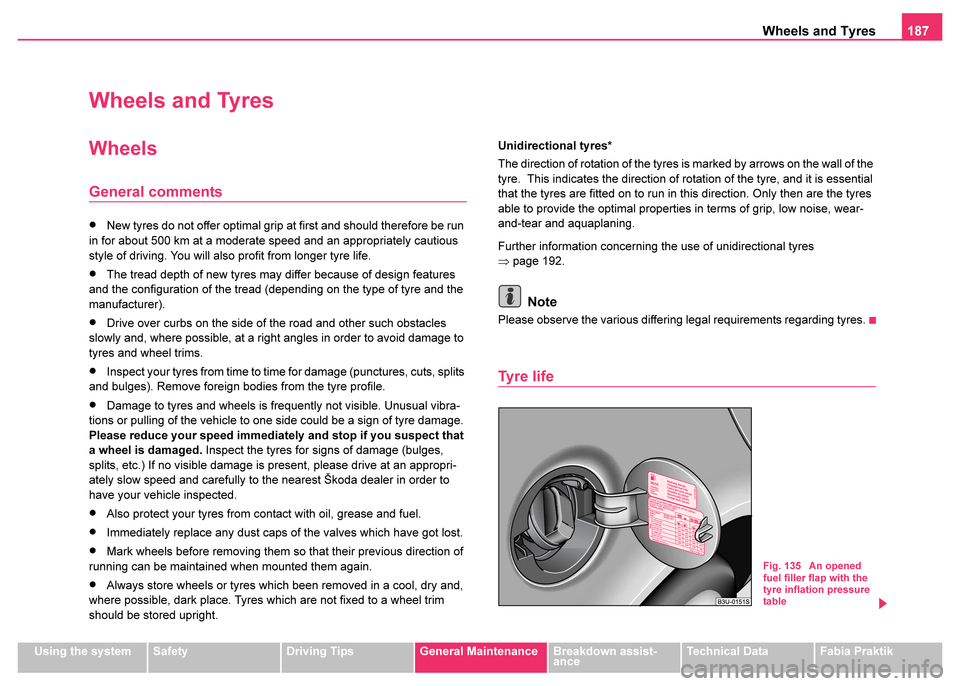
Wheels and Tyres187
Using the systemSafetyDriving TipsGeneral MaintenanceBreakdown assist-
anceTechnical DataFabia Praktik
Wheels and Tyres
Wheels
General comments
•New tyres do not offer optimal grip at first and should therefore be run
in for about 500 km at a moderate speed and an appropriately cautious
style of driving. You will also profit from longer tyre life.
•The tread depth of new tyres may differ because of design features
and the configuration of the tread (depending on the type of tyre and the
manufacturer).
•Drive over curbs on the side of the road and other such obstacles
slowly and, where possible, at a right angles in order to avoid damage to
tyres and wheel trims.
•Inspect your tyres from time to time for damage (punctures, cuts, splits
and bulges). Remove foreign bodies from the tyre profile.
•Damage to tyres and wheels is frequently not visible. Unusual vibra-
tions or pulling of the vehicle to one side could be a sign of tyre damage.
Please reduce your speed immediately and stop if you suspect that
a wheel is damaged. Inspect the tyres for signs of damage (bulges,
splits, etc.) If no visible damage is present, please drive at an appropri-
ately slow speed and carefully to the nearest Škoda dealer in order to
have your vehicle inspected.
•Also protect your tyres from contact with oil, grease and fuel.
•Immediately replace any dust caps of the valves which have got lost.
•Mark wheels before removing them so that their previous direction of
running can be maintained when mounted them again.
•Always store wheels or tyres which been removed in a cool, dry and,
where possible, dark place. Tyres which are not fixed to a wheel trim
should be stored upright. Unidirectional tyres*
The direction of rotation of the tyres is marked by arrows on the wall of the
tyre. This indicates the direction of rotation of the tyre, and it is essential
that the tyres are fitted on to run in this direction. Only then are the tyres
able to provide the optimal properties in terms of grip, low noise, wear-
and-tear and aquaplaning.
Further information concerning the use of unidirectional tyres
⇒
page 192.
Note
Please observe the various differing legal requirements regarding tyres.
Tyre life
Fig. 135 An opened
fuel filler flap with the
tyre inflation pressure
table
Page 190 of 233
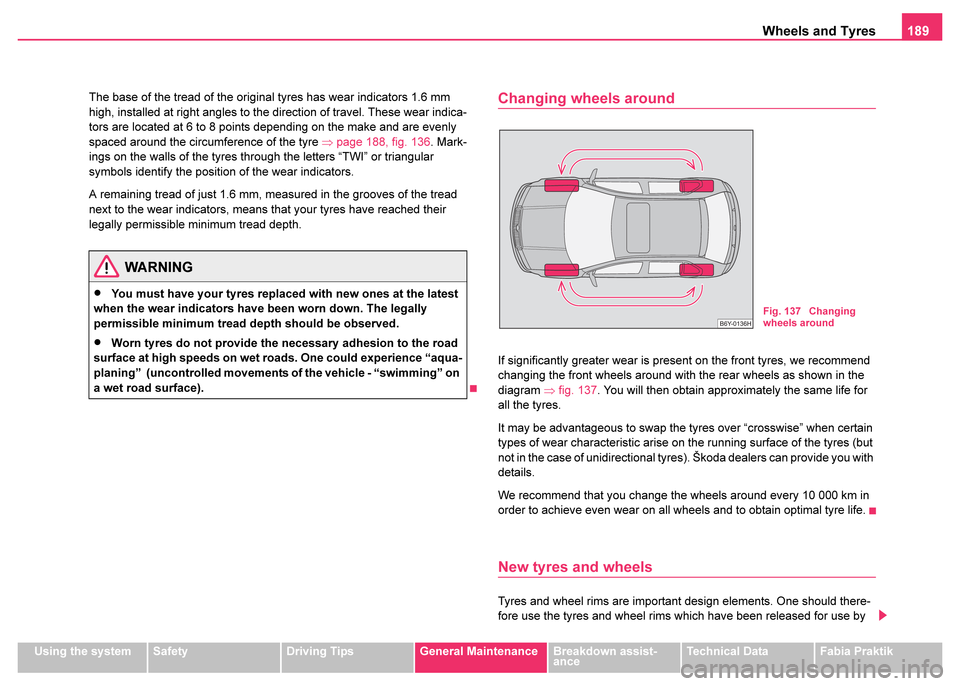
Wheels and Tyres189
Using the systemSafetyDriving TipsGeneral MaintenanceBreakdown assist-
anceTechnical DataFabia Praktik
The base of the tread of the original tyres has wear indicators 1.6 mm
high, installed at right angles to the direction of travel. These wear indica-
tors are located at 6 to 8 points depending on the make and are evenly
spaced around the circumference of the tyre
⇒page 188, fig. 136 . Mark-
ings on the walls of the tyres through the letters “TWI” or triangular
symbols identify the position of the wear indicators.
A remaining tread of just 1.6 mm, measured in the grooves of the tread
next to the wear indicators, means that your tyres have reached their
legally permissible minimum tread depth.
Changing wheels around
If significantly greater wear is present on the front tyres, we recommend
changing the front wheels around with the rear wheels as shown in the
diagram ⇒fig. 137 . You will then obtain approximately the same life for
all the tyres.
It may be advantageous to swap the tyres over “crosswise” when certain
types of wear characteristic arise on the running surface of the tyres (but
not in the case of unidirectional tyres). Škoda dealers can provide you with
details.
We recommend that you change the wheels around every 10 000 km in
order to achieve even wear on all wheels and to obtain optimal tyre life.
New tyres and wheels
Tyres and wheel rims are important design elements. One should there-
fore use the tyres and wheel rims which have been released for use by
WARNING
•You must have your tyres replaced with new ones at the latest
when the wear indicators have been worn down. The legally
permissible minimum tread depth should be observed.
•Worn tyres do not provide the necessary adhesion to the road
surface at high speeds on wet roads. One could experience “aqua-
planing” (uncontrolled movements of the vehicle - “swimming” on
a wet road surface).
Fig. 137 Changing
wheels around
Page 192 of 233
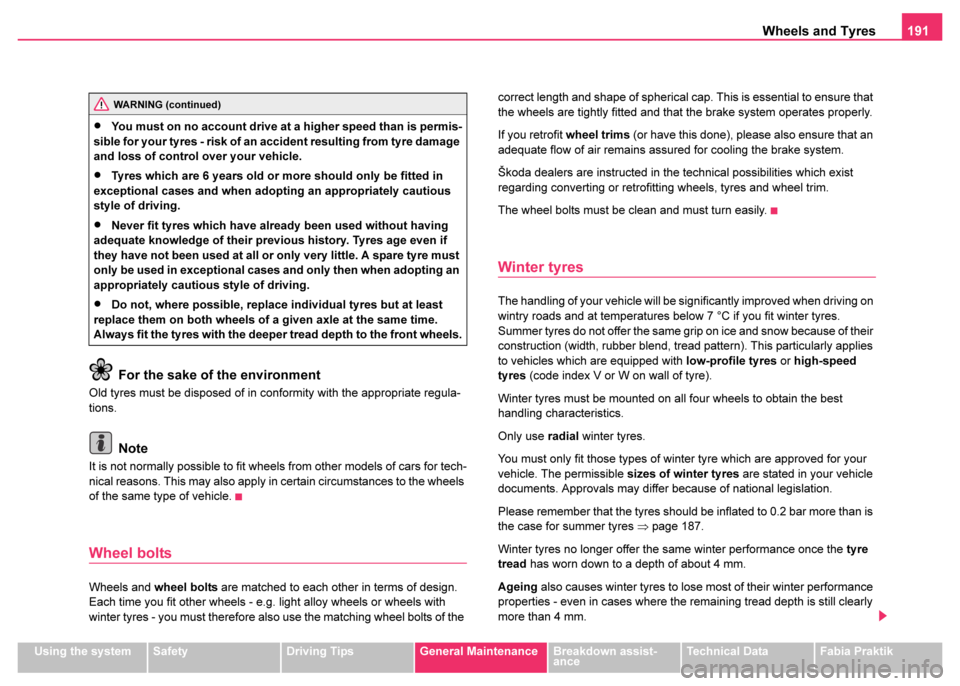
Wheels and Tyres191
Using the systemSafetyDriving TipsGeneral MaintenanceBreakdown assist-
anceTechnical DataFabia Praktik
For the sake of the environment
Old tyres must be disposed of in conformity with the appropriate regula-
tions.
Note
It is not normally possible to fit wheels from other models of cars for tech-
nical reasons. This may also apply in certain circumstances to the wheels
of the same type of vehicle.
Wheel bolts
Wheels and wheel bolts are matched to each other in terms of design.
Each time you fit other wheels - e.g. light alloy wheels or wheels with
winter tyres - you must therefore also use the matching wheel bolts of the correct length and shape of spherical cap. This is essential to ensure that
the wheels are tightly fitted and that the brake system operates properly.
If you retrofit
wheel trims (or have this done), please also ensure that an
adequate flow of air remains assured for cooling the brake system.
Škoda dealers are instructed in the technical possibilities which exist
regarding converting or retrofitting wheels, tyres and wheel trim.
The wheel bolts must be clean and must turn easily.
Winter tyres
The handling of your vehicle will be significantly improved when driving on
wintry roads and at temperatures below 7 °C if you fit winter tyres.
Summer tyres do not offer the same grip on ice and snow because of their
construction (width, rubber blend, tread pattern). This particularly applies
to vehicles which are equipped with low-profile tyres or high-speed
tyres (code index V or W on wall of tyre).
Winter tyres must be mounted on all four wheels to obtain the best
handling characteristics.
Only use radial winter tyres.
You must only fit those types of winter tyre which are approved for your
vehicle. The permissible sizes of winter tyres are stated in your vehicle
documents. Approvals may differ because of national legislation.
Please remember that the tyres should be inflated to 0.2 bar more than is
the case for summer tyres ⇒page 187.
Winter tyres no longer offer the same winter performance once the tyre
tread has worn down to a depth of about 4 mm.
Ageing also causes winter tyres to lose most of their winter performance
properties - even in cases where the remaining tread depth is still clearly
more than 4 mm.
WARNING (continued)
•You must on no account drive at a higher speed than is permis-
sible for your tyres - risk of an accident resulting from tyre damage
and loss of control over your vehicle.
•Tyres which are 6 years old or more should only be fitted in
exceptional cases and when adopting an appropriately cautious
style of driving.
•Never fit tyres which have already been used without having
adequate knowledge of their previous history. Tyres age even if
they have not been used at all or only very little. A spare tyre must
only be used in exceptional cases and only then when adopting an
appropriately cautious style of driving.
•Do not, where possible, replace individual tyres but at least
replace them on both wheels of a given axle at the same time.
Always fit the tyres with the deeper tread depth to the front wheels.
Page 194 of 233
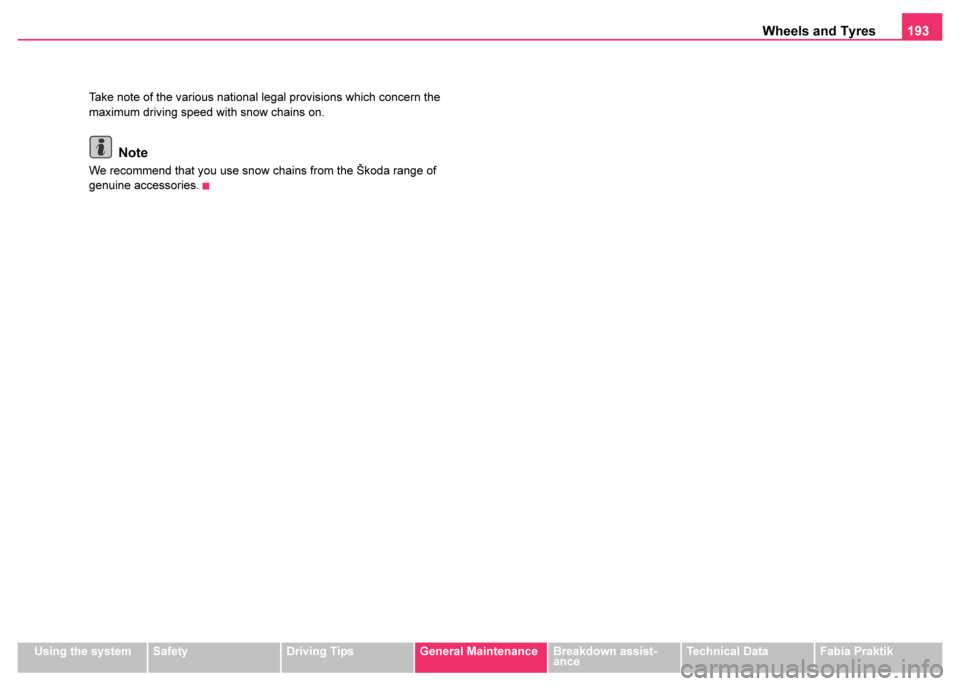
Wheels and Tyres193
Using the systemSafetyDriving TipsGeneral MaintenanceBreakdown assist-
anceTechnical DataFabia Praktik
Take note of the various national legal provisions which concern the
maximum driving speed with snow chains on.
Note
We recommend that you use snow chains from the Škoda range of
genuine accessories.
Page 196 of 233
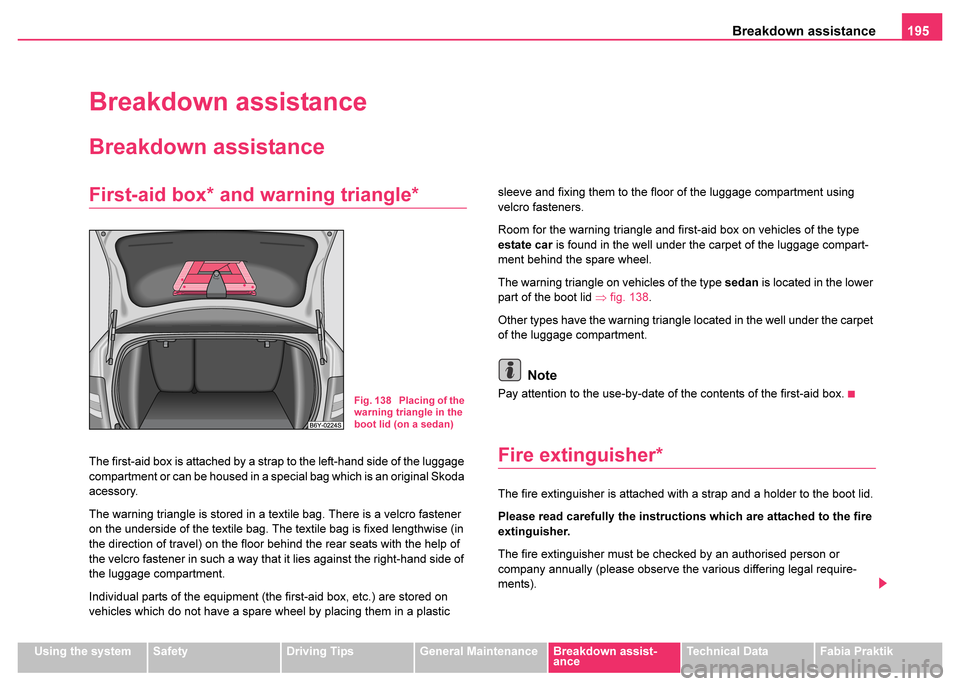
Breakdown assistance195
Using the systemSafetyDriving TipsGeneral MaintenanceBreakdown assist-
anceTechnical DataFabia Praktik
Breakdown assistance
Breakdown assistance
First-aid box* and warning triangle*
The first-aid box is attached by a strap to the left-hand side of the luggage
compartment or can be housed in a special bag which is an original Skoda
acessory.
The warning triangle is stored in a textile bag. There is a velcro fastener
on the underside of the textile bag. The textile bag is fixed lengthwise (in
the direction of travel) on the floor behind the rear seats with the help of
the velcro fastener in such a way that it lies against the right-hand side of
the luggage compartment.
Individual parts of the equipment (the first-aid box, etc.) are stored on
vehicles which do not have a spare wheel by placing them in a plastic sleeve and fixing them to the floor of the luggage compartment using
velcro fasteners.
Room for the warning triangle and first-aid box on vehicles of the type
estate car
is found in the well under the carpet of the luggage compart-
ment behind the spare wheel.
The warning triangle on vehicles of the type sedan is located in the lower
part of the boot lid ⇒fig. 138.
Other types have the warning triangle located in the well under the carpet
of the luggage compartment.
Note
Pay attention to the use-by-date of the contents of the first-aid box.
Fire extinguisher*
The fire extinguisher is attached with a strap and a holder to the boot lid.
Please read carefully the instructions which are attached to the fire
extinguisher.
The fire extinguisher must be checked by an authorised person or
company annually (please observe the various differing legal require-
ments).
Fig. 138 Placing of the
warning triangle in the
boot lid (on a sedan)
Page 198 of 233
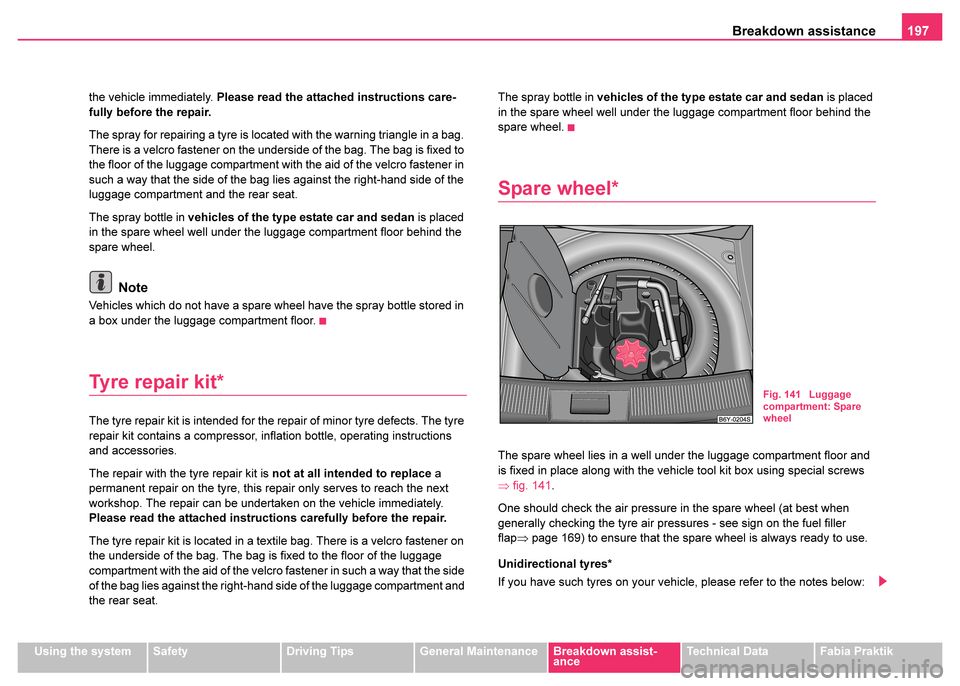
Breakdown assistance197
Using the systemSafetyDriving TipsGeneral MaintenanceBreakdown assist-
anceTechnical DataFabia Praktik
the vehicle immediately.
Please read the attached instructions care-
fully before the repair.
The spray for repairing a tyre is located with the warning triangle in a bag.
There is a velcro fastener on the underside of the bag. The bag is fixed to
the floor of the luggage compartment with the aid of the velcro fastener in
such a way that the side of the bag lies against the right-hand side of the
luggage compartment and the rear seat.
The spray bottle in vehicles of the type estate car and sedan is placed
in the spare wheel well under the luggage compartment floor behind the
spare wheel.
Note
Vehicles which do not have a spare wheel have the spray bottle stored in
a box under the luggage compartment floor.
Tyre repair kit*
The tyre repair kit is intended for the repair of minor tyre defects. The tyre
repair kit contains a compressor, inflation bottle, operating instructions
and accessories.
The repair with the tyre repair kit is not at all intended to replace a
permanent repair on the tyre, this repair only serves to reach the next
workshop. The repair can be undertaken on the vehicle immediately.
Please read the attached instructions carefully before the repair.
The tyre repair kit is located in a textile bag. There is a velcro fastener on
the underside of the bag. The bag is fixed to the floor of the luggage
compartment with the aid of the velcro fastener in such a way that the side
of the bag lies against the right-hand side of the luggage compartment and
the rear seat. The spray bottle in
vehicles of the type estate car and sedan is placed
in the spare wheel well under the luggage compartment floor behind the
spare wheel.
Spare wheel*
The spare wheel lies in a well under the luggage compartment floor and
is fixed in place along with the vehicle tool kit box using special screws
⇒ fig. 141 .
One should check the air pressure in the spare wheel (at best when
generally checking the tyre air pressures - see sign on the fuel filler
flap ⇒page 169) to ensure that the spare wheel is always ready to use.
Unidirectional tyres*
If you have such tyres on your vehicle, please refer to the notes below:
Fig. 141 Luggage
compartment: Spare
wheel
Page 200 of 233
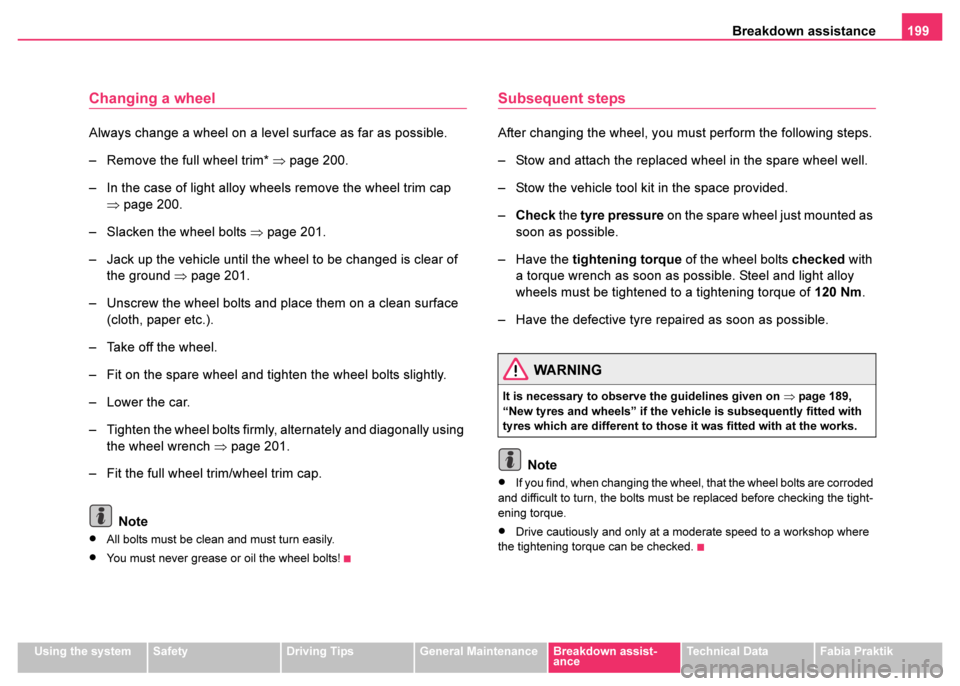
Breakdown assistance199
Using the systemSafetyDriving TipsGeneral MaintenanceBreakdown assist-
anceTechnical DataFabia Praktik
Changing a wheel
Always change a wheel on a leve l surface as far as possible.
– Remove the full wheel trim* ⇒page 200.
– In the case of light alloy wheels remove the wheel trim cap ⇒page 200.
– Slacken the wheel bolts ⇒page 201.
– Jack up the vehicle until the wheel to be changed is clear of the ground ⇒page 201.
– Unscrew the wheel bolts and place them on a clean surface (cloth, paper etc.).
– Take off the wheel.
– Fit on the spare wheel and tighten the wheel bolts slightly.
– Lower the car.
– Tighten the wheel bolts firmly, alternately and diagonally using the wheel wrench ⇒page 201.
– Fit the full wheel trim/wheel trim cap.
Note
•All bolts must be clean and must turn easily.
•You must never grease or oil the wheel bolts!
Subsequent steps
After changing the wheel, you must perform the following steps.
– Stow and attach the replaced wheel in the spare wheel well.
– Stow the vehicle tool kit in the space provided.
–Check the tyre pressure on the spare wheel just mounted as
soon as possible.
– Have the tightening torque of the wheel bolts checked with
a torque wrench as soon as possible. Steel and light alloy
wheels must be tightened to a tightening torque of 120 Nm.
– Have the defective tyre repaired as soon as possible.
Note
•If you find, when changing the wheel, that the wheel bolts are corroded
and difficult to turn, the bolts must be replaced before checking the tight-
ening torque.
•Drive cautiously and only at a moderate speed to a workshop where
the tightening torque can be checked.
WARNING
It is necessary to observe the guidelines given on ⇒page 189,
“New tyres and wheels” if the vehicle is subsequently fitted with
tyres which are different to those it was fitted with at the works.
Page 202 of 233

Breakdown assistance201
Using the systemSafetyDriving TipsGeneral MaintenanceBreakdown assist-
anceTechnical DataFabia Praktik
Slackening and tightening wheel bolts
Slacken the wheel bolts before jacking up the vehicle.
Slackening wheel bolts
– Push the wheel wrench fully onto the wheel bolt
4).
– Grasp the end of the wrench and turn the bolt about one turn
to the left ⇒fig. 144 .
Tightening wheel bolts
– Push the wheel wrench fully onto the wheel bolt
4).
– Grasp the end of the wrench and turn the bolt to the right until it is tight. Note
Apply pressure carefully with your
foot to the end of the wheel wrench if
it proves difficult to slacken the wheel bolts. Hold tight on the vehicle when
doing this and ensure that you have a steady position.
Car jack
You have to raise the vehicle with a lifting jack in order to
be able to take off the wheel.
4)Use the appropriate adapter for slackening and tightening the safety wheel bolts
⇒ page 202.
Fig. 144 Changing a
wheel: Slackening
wheel bolts
WARNING
Slacken the wheel bolts only a little (about one turn) as long as the
vehicle has not yet been jacked up - risk of an accident!.
Fig. 145 Changing a
wheel: Points for posi-
tioning car jack